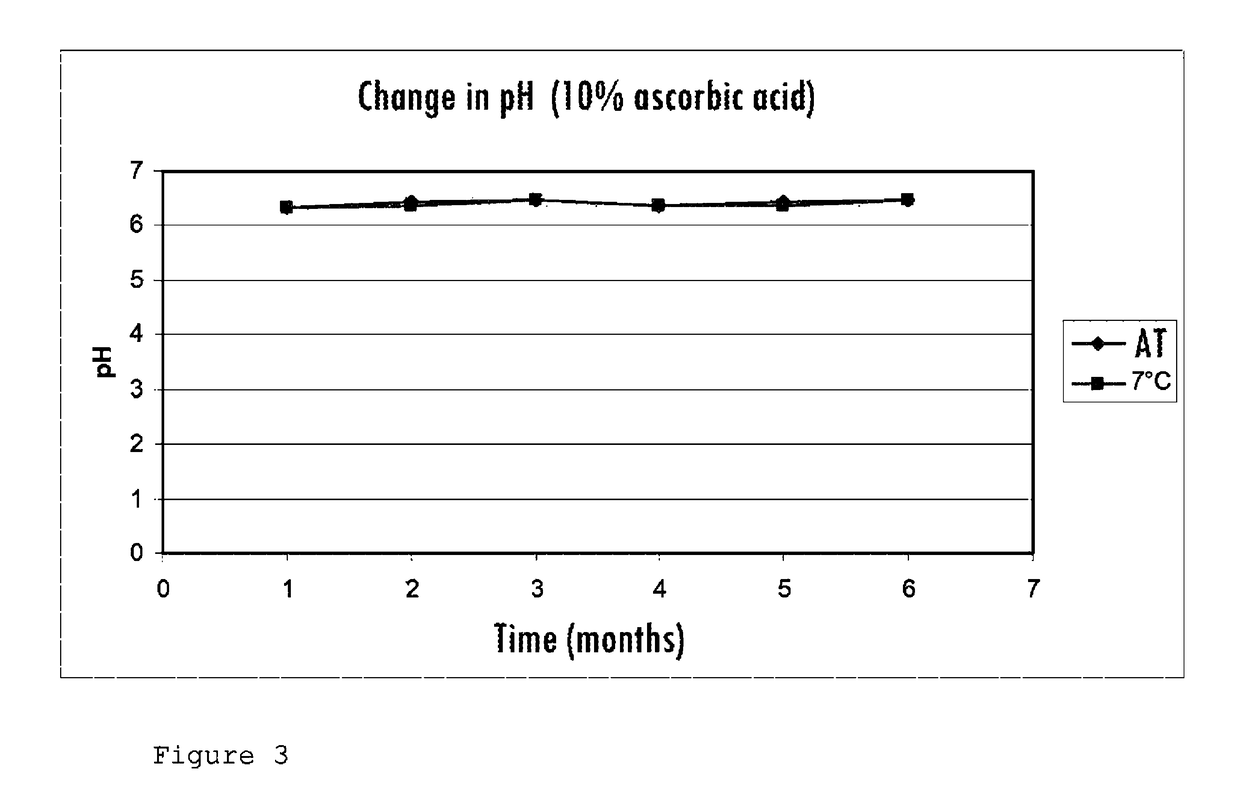Method for obtaining a stable gel of hyaluronic acid and of a free form of vitamin C and/or a salt thereof
a technology of hyaluronic acid and stable gel, which is applied in the directions of aerosol delivery, inorganic non-active ingredients, drug compositions, etc., can solve the problems of liquefaction of gel, inability to produce a gel that is sufficiently stable, and inability to obtain stable gel
- Summary
- Abstract
- Description
- Claims
- Application Information
AI Technical Summary
Benefits of technology
Problems solved by technology
Method used
Image
Examples
example 1 (comparative)
slinked Gel Swelled without Addition of Vitamin C
[0075]The contents of 5 syringes of commercial monophasic cross-linked monophasic gel are placed in a 25-ml Duran flask. The gel is sterilized in the autoclave at a temperature of 121° C. for 15 minutes.
[0076]The gel obtained after sterilization is translucent and colorless, and retains an appearance similar to what it had before treatment in the autoclave. The gel has not deteriorated due to the absence of vitamin C in the composition.
example 2 (comparative)
uronic Acid Gel with Addition of Vitamin C
[0077]0.5 g of ascorbic acid and 5 ml of water are placed in a 25-ml Duran flask. They are mixed until totally dissolved, after which 194 mg of hyaluronic acid (HA), obtained from a commercial source and pre-isolated in a solid form of solid purified HA, is added.
[0078]The flask containing the preparation is hermetically sealed and slowly agitated for 3 hours, then left at ambient temperature for 2 hours until the gel is completely swollen, then treated in the autoclave at 121° C. for 15 minutes in order to be sterilized.
[0079]After treatment in the autoclave, the gel has deteriorated into a clear solution with a pronounced yellow color.
example 3
tion of a Hyaluronic Acid Gel, with Addition of Vitamin C and Metabisulfite in the Solid Phase, without Performing a Degassing Step
[0080]The gels are prepared as describe above, but without degassing.
[0081]
ascorbicSolidExample 3acidNaHCO3Na2S2O5HA (*)WaterSample 11.0 g0.5 g 8 mg396 mgenough(10% m / v)(5% m / v)(0.08%(3.96%water tom / v)m / v)make 10 mlSample 20.5 g0.25 g50 mg192 mgenough(10% m / v)(5% m / v)(1% m / v)(3.84%water tom / v)make 5 ml(*) HA: Hyaluronic acid; NaHCO3: Sodium bicarbonate; Na2S2O5: Sodium metabisulfite
[0082]With 1% m / v corresponding to a mass concentration of 1 g per 100 ml.
[0083]In both cases, the gel retains its gel-like appearance without any significant visual difference in texture compared to the commercial gel. However, it has a yellow coloration after treatment in the autoclave.
[0084]Increasing the metabisulfite concentration by a factor of 12.5 between the two tests does not solve the problem.
PUM
| Property | Measurement | Unit |
|---|---|---|
| temperature | aaaaa | aaaaa |
| temperature | aaaaa | aaaaa |
| molar mass | aaaaa | aaaaa |
Abstract
Description
Claims
Application Information
 Login to View More
Login to View More - R&D
- Intellectual Property
- Life Sciences
- Materials
- Tech Scout
- Unparalleled Data Quality
- Higher Quality Content
- 60% Fewer Hallucinations
Browse by: Latest US Patents, China's latest patents, Technical Efficacy Thesaurus, Application Domain, Technology Topic, Popular Technical Reports.
© 2025 PatSnap. All rights reserved.Legal|Privacy policy|Modern Slavery Act Transparency Statement|Sitemap|About US| Contact US: help@patsnap.com


